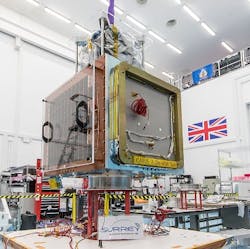Optical Surfaces ultraflat mirrors chosen for Earth Observation Satellite Telescope testing
Optical Surfaces (Surrey, England) received an order from Surrey Satellite Technology Limited (SSTL; Guildford, England) for two high precision reference mirrors to accelerate the precise alignment and testing of their Earth Observation Satellite Telescopes.
SSTL manufactures and operates small- to medium-sized satellites, covering a range of use cases, from telecoms to Earth observation. Earth observation (EO) satellites are a core product for SSTL and each EO satellite undergo a rigorous process of testing and verification before and after launch. As SSTL's business has grown it required additional high-precision reference mirrors to enable testing of its telescope optical systems in parallel.
Aris Kouris, sales director at Optical Surfaces said, "We are pleased to have been entrusted once again by SSTL to deliver two demanding mounted reference flat mirrors for the purposes of verifying the wavefront performance of their EO telescopes during their assembly and as an alignment aid. The clear aperture of these mirrors was 300mm in diameter with a central hole of 100mm in diameter and the achieved surface accuracy was nearly L/15 P-V at 633nm. This target was particularly challenging since the mounted mirrors had to be tested in a 'non-standard' vertical orientation. Ensuring that the Lambda/15 p-v target was a true representation of the mirror required extensive testing and consequent adjustments in both, the testing as well as mounting strategy. During these tests all, possible sources of error were isolated, analysed and accounted for to confirm in a positive manner that the high specifications of the mounted mirrors supplied to SSTL were what we claimed them to be. Potential sources of error during the testing included intrinsic errors in our reference flat, mounting distortions on our reference flat and the UUT but also gravity effects on both the reference flat and the UUT. All these errors had to be disentangled and considered during the manufacturing process and we feel that we have done this in the best possible and most reliable way." Kouris added, "I can definitely say that we are extremely pleased with the outcome and being able to assist SSTL with their challenging alignment and testing requirements."
Robin Cole, optical systems engineer at SSTL, said, "There are very few suppliers who can produce such large optics with the specifications we required. We had an additional requirement for a custom mounting configuration, for which Optical Surfaces Ltd. were able to propose and deliver a suitable design. We have worked with Optical Surfaces Ltd. on previous projects and have high confidence in their ability to deliver high specification optics on time and at a competitive price. From start to finish Optical Surfaces Ltd. operate a highly efficient and professional service, always engaging with enthusiasm and drawing on decades of experience to provide robust and innovative optical solutions."
SOURCE: Optical Surfaces; https://www.optisurf.com/index.php/improving-alignment-testing-earth-observation-satellites/

Gail Overton | Senior Editor (2004-2020)
Gail has more than 30 years of engineering, marketing, product management, and editorial experience in the photonics and optical communications industry. Before joining the staff at Laser Focus World in 2004, she held many product management and product marketing roles in the fiber-optics industry, most notably at Hughes (El Segundo, CA), GTE Labs (Waltham, MA), Corning (Corning, NY), Photon Kinetics (Beaverton, OR), and Newport Corporation (Irvine, CA). During her marketing career, Gail published articles in WDM Solutions and Sensors magazine and traveled internationally to conduct product and sales training. Gail received her BS degree in physics, with an emphasis in optics, from San Diego State University in San Diego, CA in May 1986.
